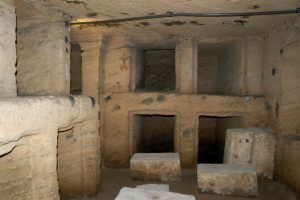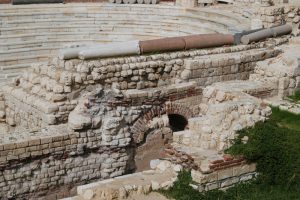We started at eight for the drive to Alexandria. We will meet our guide in the city, so Mr. Mohammed is charged with us for the day. He must be getting heartily sick of us! After a wrong turn and a backtrack to get on the desert road, we’re off. Another security police officer has been assigned to us, a younger guy — again, named Mohammed — but he doesn’t speak English at all. He and Mr. Mohammed chatter away the entire time.
Alexandria
We stopped about halfway to Alexandria, because the only person in the car who was awake was Mr. Mohammed and he was fading fast. We need coffee, and tea, and a cigarette, he said. We all piled into the rest stop to sit down and drink a little and walk around.
When we pulled into the rest stop, there were crews of people in uniform who will wash the car for a few pounds. There is a lot of traffic between Cairo and Alexandria, and many farms and industrial sites along the way. I imagine the car-washers do a brisk business during the week.
Alexandria is a much cleaner city that Cairo, and laid out in a grid that seems very modern. The city is very cosmopolitan, much more a European city than an Egyptian one. Compared to the clamor and smog of Cairo, Alexandria seems positively serene. The older part of the city is lovely, with beautiful old buildings and narrow streets. It makes driving a bit exciting, with streets so narrow the van doesn’t fit, but the city is charming.
Touring Alexandria is a half-day affair for most people. The major sites can be seen in a lazy morning and leave the rest of the day to explore the city. Even dawdlers such as Mark and me stretched it out only until early afternoon.
Alexandria Sights

We picked up our guide for the day, Amel, a nice young woman who speaks faster than I do. Our first stop is the Greco-Roman Museum, which, like everything in Egypt, is under renovations. It’s a very small museum, fairly unorganized, and although it is reputed to have 10000 items on display, it seems pretty sparse. Some of the statuary is beautiful, and some is…odd. The statues have the standard pharaonic poses (one foot forward, hands clenched at the sides, head up and staring forward)…with Roman features. There are Egyptian gods in Roman clothing. It’s startling and strange and almost comical in some cases.
It’s an interesting look at how religions change — keeping the iconography of the “old” ways and melding them with the new. Isis became Aphrodite, Horus became Apollo…after weeks of looking at the formulaic features of Egyptian statuary, seeing the familiar faces of Greek sculpture on the same bodies is odd.
Then off to the catacombs of Shouqafa, a series of chambers and pits for underground crypts.They were discovered by accident (I think by a donkey again!), and contain several levels of medieval burial chambers and Roman crypts. It’s really kind of creepy and smells odd and musty. The crypts are accessed through a spiral staircase, and only the two upper tiers are accessible. The lower levels have been flooded for years.
A large gallery just inside was filled with pottery when they excavated it. The families of the dead would bring a packed lunch and eat in the tomb after visiting the dead. Our guide didn’t know if this was a ritual meal or not, but she did point out that it was “bad luck” to remove anything from the graves, so the plates and mugs were simply smashed down here instead of taking them away.

Wooden planks form a walkway down into the tombs. Even though I know that there aren’t any bodies in the openings, I keep expecting to see one .I remember seeing a television special about catacombs that were found in Alexandria while excavating for a new freeway. They dug down with bulldozers and suddenly found themselves in five or six stories of Roman catacombs — mostly filled with water — still decorated and, gruesomely, still :”populated”. That, and the scenes from Indiana Jones with the rats keep popping into my head.
At one end of the catacombs is a huge shaft tomb that was found with the bones of hundreds of horses inside. Our guide couldn’t explain it. She thinks that it was actually a tomb, not just a garbage pit. The shaft tomb is brick, not just stone, and the walls are decorated.
Very nearly across the street is the single column called Pompey’s Pillar. It is much, much bigger than I thought it would be. It’s HUGE — and supposedly from a temple with over 400 similarly sized columns. Probably standard historic hyperbole. From a distance, it looks gray. Up close, it’s the pink granite that we’ve seen all over egypt. The pillar is on a big hill with a number of other excavations, including a nilometer, cisterns, and some other foundations. There are some pharaonic statues here — two sphinxes, one of them headless — that seem to be placed at random. Even though the pillar itself stands on a hill, the entire site is still below the street level of much of the surrounding city.
Villa of the Birds and Roman Streets
Amel asks for ten minutes to pray at noontime, and we wander around the gardens before going to the Roman amphitheater. There’s a current dig going on around the theatre that has excavated a Roman street, including houses and shops. The theatre is intact: it seats about 700 on marbles seats and the underground staging areas and side rooms are still accessible. It’s been “renovated” to be the backdrop for a modern theater and is used for plays and musicals. We got extra tickets for the Villa of the Birds on the same site. The extra few pounds were definitely worth it. Inside this small, carefully excavated Roman home are exquisite mosaics of birds, animals, and geometric patterns on the floors of the home.
They’ve built a display above the floor and walls so you can walk around the house and it’s protected from the rains, etc. You can see that these fabulous, detailed, glorious mosaics were common place — used as carpets in living spaces. Admittedly, in very rich homes, but they aren’t ART in the “look at it on the wall” sort of way we see them now.
There’s a roman bath that is being excavated near the theatre While we can’t get too close to it, we can see the different rooms had sewers leading away from the rooms of the brick baths. We couldn’t explore it because the open dig is between it and the amphitheater, but we got some interesting pictures.

A few of the statues that have been pulled from the harbor – sphinxes and a few other statues from the ruined palace of Cleopatra in the sea are here. A glass-bottomed boat tour of the harbor is planned. Scuba diving in the harbor is available, as well, from a number of companies in Alexandria.
The Citadel is unfortunately closed for renovations (are you surprised?) so we can only see the outside from the very windy and cold pier. It looks like a french castle and is built on the foundations of the fabled Pharos lighthouse. Blocks from the lighthouse have been found in the harbor along with the remains of temples and other monuments Diving expeditions to view the statues in the harbor are available (pretty cold right now!) and there are plans to open an “underwater” museum of sorts.
The hotel we are staying at tonight (El Salamlek) is in Montazah Gardens and it one of the nicest hotels we’ve stayed at. The small hotel is a former palace of King Farouk and has only six rooms. We’re in a “Junior Suite” which has the huge, vaulted wooden ceiling in the main tower of the palace. Its like being in a ship! (A statement that I made about four thousand times).
And the sheets have to be something like 1000-thread cotton. They feel like a fine, smooth, almost velvety dress shirt. Lovely!
Obligatory McDonalds Meal
Every trip, we make a stop into a McDonalds — they are everywhere, and it seems to be a quintessential American export. So, just to compare the “standard”, we have one (and only one!) meal in a local McDonalds.
We venture out for our single fast-food meal. There’s something odd about leaving a very elegant 5-star hotel for lunch in McDonalds and we had a good laugh about it. . It’s just a quick walk through he gardens,and the McDonalds is actually on the grounds of the hotel, so it can’t be that uncommon to zip across for fries.
Not surprisingly, the meal is different. The fries are the same, but the Quarter Pounder is humongous!. I mean, 6″ across and perfectly round, and the bun is substantially larger than those at home. It takes two hands to hold. We actually pulled out a dollar bill (6″ long) to measure it, we were so surprised.
It doesn’t actually taste like 100% beef (and, in retrospect, it doesn’t say anywhere that it is one hundred percent beef) and has an odd, sausage-filler taste and chewy texture. Plus, the meat is much more peppery/spicy than at home. Good, though. We simply can’t figure out why it’s so huge. Some law that says it must be 1/4 pound after cooking? Extra size for the filler so it has 1/4 lb beef? Everything is bit sweeter — the ketchup, the diet pepsi, the pickles. The Diet Pepsi came with ice, usually a no-no, but we’re trusting McDonalds quality control.
The staff brought the food out to us after making it completely fresh, as they did for every customer. So, McDonalds is a strange cross between fast-food and table service. The apple pie was fried, too. Quite a treat.
It started to rain on the walk back to the hotel and by the time we reached the door, it was howling in from the sea. The windows all have shutters and we could hear the hotel creaking in the wind and rain. We decided to eat in and napped until our 9pm seating. I had pasta, Mark had sea bass. It was ok, but not fabulous. The room is very very blue and very french. Ordering was fun — we shared not single language between us, instead managing a strange pidgin of Arabic, English, and French — and eating fairly good italian food in a French-speaking Egyptian restaurant was an adventure.
The wind was so fierce it was hard to sleep — rattling the shutters and windows and, I think, pulling a few tiles off the roof. About one in the morning, I found the rattling window pane and jammed bits of paper around it to stop the rattle.
Ah, silence. A rare thing on our trip.